A Fidicinoides spinicosta from the collection of Richard Newfrock. Colombia. Misspelling on the label.
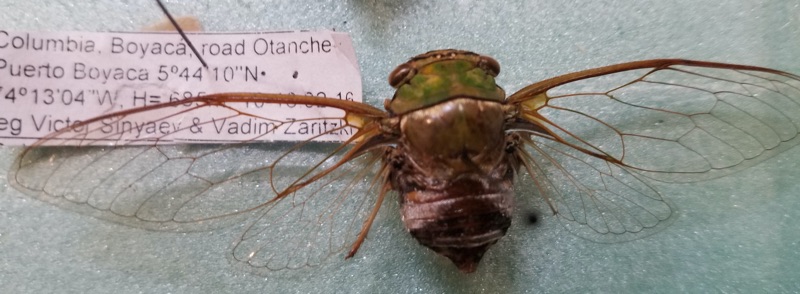
A Fidicinoides spinicosta from the collection of Richard Newfrock. Colombia. Misspelling on the label.

Quesada gigas (Olivier, 1790) Is a cicada found in the United States (Texas), Argentina, Belize, Bolivia, Brazil, Colombia, Costa Rica, Ecuador, Guatemala, Guyana, Mexico, Panama, Paraguay, Peru, Tobago, Trinidad, and Venezuela. It is the largest cicada in these locations.
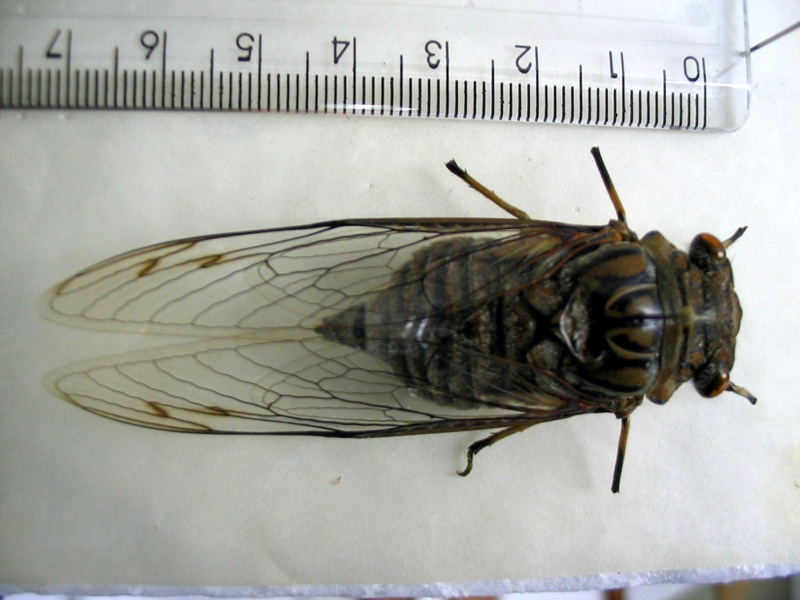
Quesada gigas from Brazil, Photo by Leonardo Milhomem.
See all Quesada gigas photos and information on cicadamania.com.
Source: ©Insect Singers | Species: Q. gigas
Playlists contain multiple videos found on YouTube.
Scientific classification:
Family: Cicadidae
Subfamily: Cicadinae
Tribe: Fidicinini
Genus: Quesada
Species: Quesada gigas (Olivier, 1790)
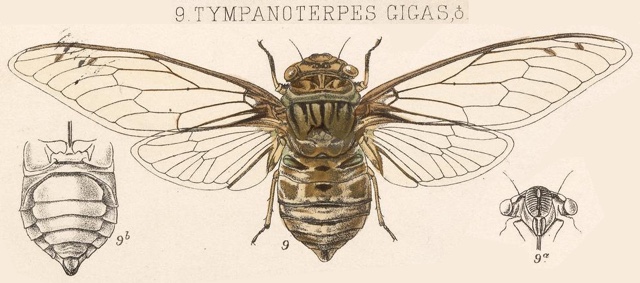
The image says Tympanoterpes gigas but its newest name is Quesada gigas.
Stal treated this species as a synonym of T. grossa, Fabr. The type of the Fabrician species, however, is in the Banksian collection contained in the British Museum, and is very distinct, the opercula being large and rounded.
The figure given in the Encyclopedic Methodique is, like Stal’s, useless for any practical purpose. Among the habitats of this wide-ranging species is that given by Walker 2, ” West coast of America,” which, as before remarked in connexion with other species, seems clearly to refer to Central America. The forms inhabiting this region (of which a Guatemalan specimen is figured) appear to be somewhat smaller than more southern specimens, or do not exhibit the gigantic specimens which are frequently and commonly received from the southern portion of the Neotropical Region.
Mr. Gervase F. Mathew (Ent. Mo. Mag. xi. p. 175) gives some interesting details relating to this insect as observed at Tobago. As regards its powers of stridulation he writes of a ” tropical afternoon: ” — ” Suddenly, from right above, you hear one or two hoarse, monotonous cries something like the croak of a tree-frog, and, looking upwards, wonder what it can be. But wait a moment ; this is merely a signal ; for the next minute everywhere above and around you these croaks are repeated in rapid and increasing succession until they merge into a long shrill whistle almost exactly similar to the whistle of a first-rate locomotive ; this continues for nearly half a minute, and then abruptly terminates.” ” Presently similar cries will be heard in the far distance, as if in reply to those which have just died away overhead. The whistling pierces one’s ears to such a degree that its vibrations can be felt long after it has ceased.”
Mr. Mathew describes this species as frequenting trees growing in ravines where the soil is generally soft and damp, in which their larvae and pupae find no difficulty in burrowing. ” When the latter are full-grown and ready for their last transformation, they emerge from the ground and crawl about four or five feet up the trunk of a tree, when they firmly fix themselves to the bark by means of their powerfully hooked fore tibiae.” ” The flight of the mature Cicada is abrupt, rapid, and by no means graceful ; and it does not appear to have the power of controlling itself when on the wing ; for I have often seen it fly in an insane manner against the trunk of a tree, a branch, or any other object that might be in its line of flight; and when it has performed its journey without any accident, it alights abruptly and awkwardly. As a rule, however, it does not attempt to fly to any great distance at a time.”
The Giant Cicada / Chicharra Grande page on the Texas Entomology websites is a very good resource, particularly in relation to the state of Texas.
Fidicinoides pronoe (Walker, 1850) is a cicada found in Mexico, Guatemala, Panama, Costa Rico, Columbia, and Brazil.
Fidicinoides pronoe was formerly known as Fidicina pronoe. Its name changed when it moved from the Fidicina Amyot & Audinet-Serville, 1843 genus to the Fidicinoides Boulard & Martinelli, 1996 genus.
Scientific classification:
Family: Cicadidae
Subfamily: Cicadinae
Tribe: Fidicinini
SubTribe: Fidicinina
Genus: Fidicinoides
Species: Fidicinoides pronoe (Walker, 1850)
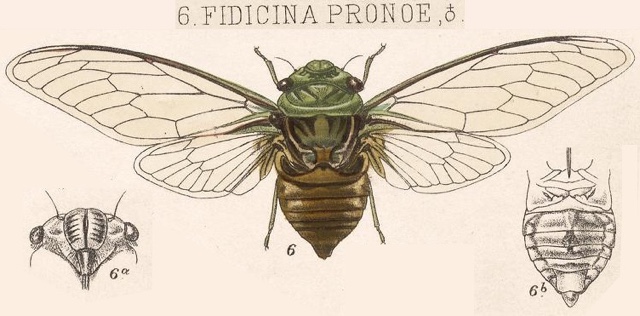
The image says Fidicina pronoe, but the newest name of this cicada is Fidicinoides pronoe.
Zammara brevis (Distant, 1905) is a cicada found in Columbia.
It was formerly known as Orellana brevis, as you can see from the image below. The Zammara and Orellana genera are very similar — both belong to the tribe Zammarini, both share pronounced pronotal collars and often green coloring.
Scientific classification:
Family: Cicadidae
Subfamily: Cicadinae
Tribe: Zammarini
Genus: Zammara
Species: Zammara brevis (Distant, 1905)
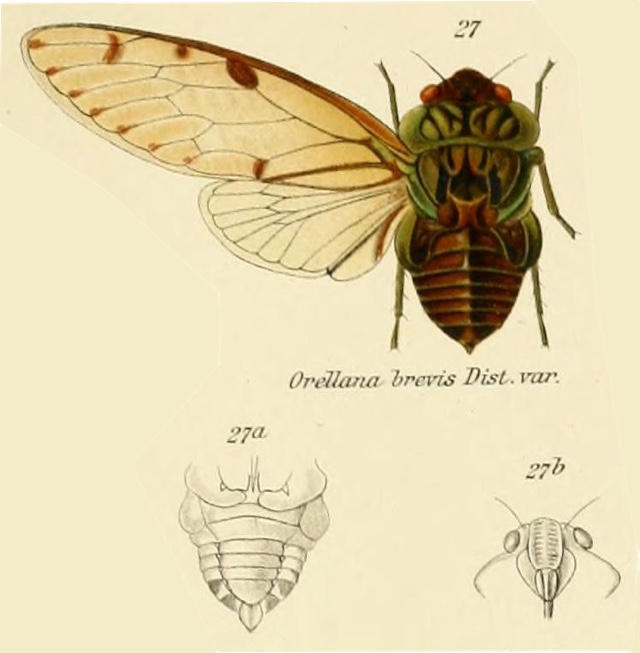
The image says Orellana brevis, but the newest name of this cicada is Zammara brevis.
Zammara genus description by W. L. Distant from Genera Insectorum, 1914:
Characters. — Head (including eyes) about as wide as base of mesonotum, ocelli farther removed from eyes than from each other, eyes prominent but scarcely projecting beyond the anterior pronotal angles, vertex strongly depressed before base of front; face longer than broad, narrowly sulcate; pronotum shorter than mesonotum, the lateral margins angularly ampliate; mesonotum about as long as head and pronotum together; metanotum exposed; abdomen short; tympanal coverings outwardly complete, the orifices very widely exposed internally; opercula short, oblique; rostrum reaching or slightly passing the posterior coxae; tegmina usually three times as long as broad, apical areas eight; wings with six apical areas.
Ariasa colombiae (Distant, 1892) is a cicada found in Columbia and Venezuela.
Scientific classification:
Family: Cicadidae
Subfamily: Cicadinae
Tribe: Fidicinini
SubTribe: Guyalnina
Genus: Ariasa
Species: Ariasa colombiae (Distant, 1892)
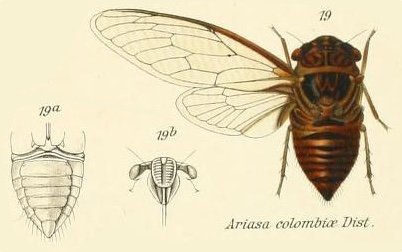
Ariasa genus description by W. L. Distant:
Characters. — Head (including eyes) wider than base of mesonotum, the eyes projecting beyond anterior pronotal angles, vertex at area of ocelli as long as or only a little shorter than front; posterior angles of pronotum more or less sublobately produced; abdomen about as long as space between apex of head and base of cruciform elevation; tympana largely exposed, the flaps only upwardly developed on the lateral areas; face large and globose; rostrum reaching the posterior coxae; opercula short, not passing base of abdomen; abdomen beneath prominently channeled at each lateral margin; tegmina and wings hyaline, the first with eight apical areas, basal cell a little longer than broad.
Pachypsaltria cinctomaculata (Stål, 1854) is found in Columbia, Bolivia, Ecuador, and Venuezela.
Scientific classification:
Family: Cicadidae
Subfamily: Cicadinae
Tribe: Cicadatrini
Genus: Pachypsaltria
Species: Pachypsaltria cinctomaculata (Stål, 1854)
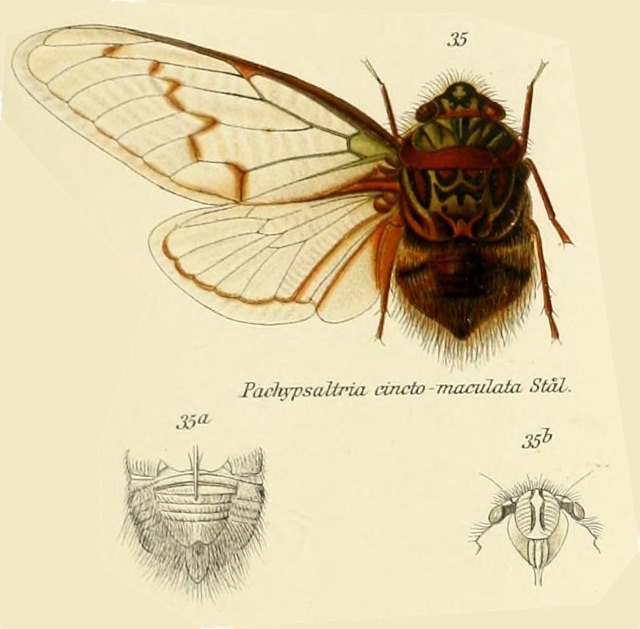
Pachypsaltria genus description by W. L. Distant:
Characters. — Head including eyes a little more than half the width of base of mesonotum, the front subconically produced, about as long as vertex, head obliquely depressed, eyes oblique, slightly passing the anterior pronotal angles; face moderately globose, not longitudinally sulcate; rostrum passing the posterior coxas; pronotum shorter than mesonotum, its posterior margin nearly twice as broad as anterior margin, the lateral margins dentately sinuate; mesonotum shorter than head and pronotum together, convex; abdomen short, about as long as head and pronotum together; tympanal orifices inwardly exposed; opercula short, broad, scarcely extending beyond base of abdomen: body pilose, marginally longly so; anterior femora not spined beneath; tegmina more than twice longer than broad, apical areas eight; wings with six apical areas.
Pachy (Greek) means thick, and psalt comes from “psalter” (Greek), which means harp player. Pachypsaltria = thick harp player.